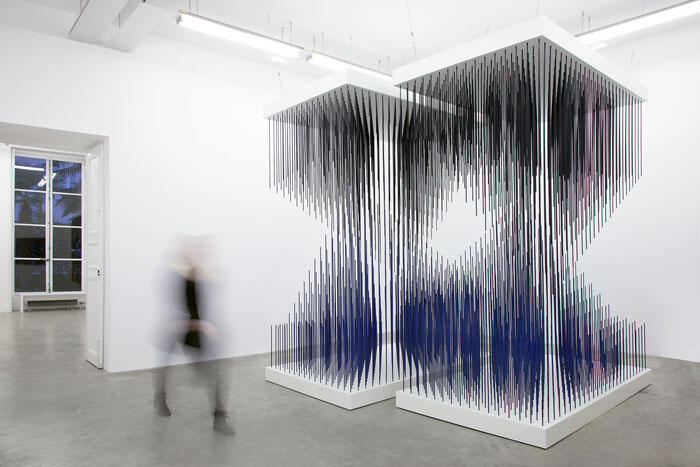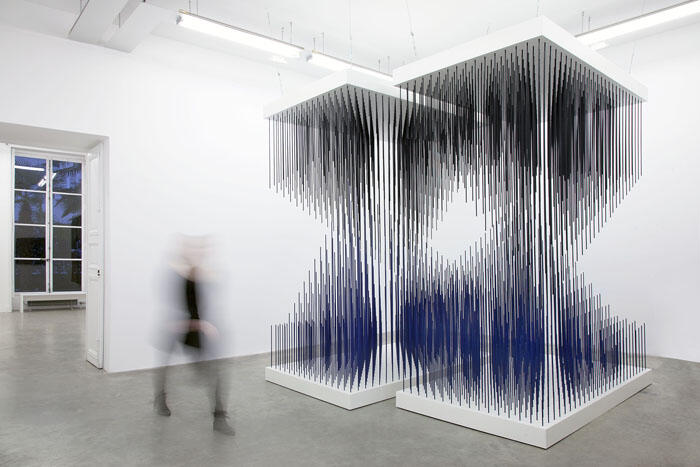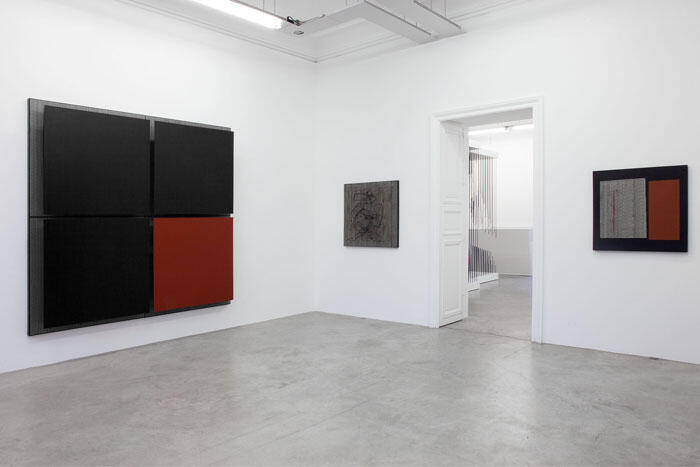Jesús Rafael SOTO _Chronochrome_
Curated by Matthieu Poirier
Galerie Perrotin, Paris (10 January - 28 February 2015)
Galerie Perrotin, New York (15 January - 21 February 2015)
Galerie Perrotin presents “Chronochrome,” a double exhibition dedicated to Jesús Rafael Soto (1923-2005), held simultaneously in its Paris and New York spaces.

Organized in collaboration with the artist’s Estate and curated by Matthieu Poirier, the exhibition presents some sixty works from private collections or institutions, created between 1957 and 2003. Soto’s work continues to draw international attention: in 2012, Grey Art Gallery in New York presented “Soto: Paris and Beyond, 1950-1970”, a large exhibition of fifty works by the artist and in 2013, the Musée National d’Art Moderne-Centre Georges Pompidou exhibited twenty donated key works of the artist. In 2014, the Museum of Fine Arts in Houston and the Art Institute of Chicago respectively presented two installations, “Houston Penetrable” and “Pénétrable de Chicago”. Soto’s works occupied an important place in the exhibitions “Dynamo. A Century of Light and Motion in Art. 1913-2013” at Galeries Nationales du Grand Palais (2013), and the recent “ZERO: Countdown to Tomorrow, 1950s–60s” at the Guggenheim Museum in New York, in the Frank Lloyd Wright building where Soto had a major retrospective back in 1974.
Jesús Rafael Soto was born in Venezuela in 1923. He trained at art school in Caracas and came to Paris in 1950, where he lived alternatively with Caracas for the rest of his life. His work developed gradually from his first Parisian pieces, created partly under the influence of the Neoplasticism of Piet Mondrian and the theories of Laszló Moholy-Nagy on light and transparency in his writings “Vision in Motion”. The title “Chronochrome” of this double exhibition, describes the kinetic exploration of the monochrome in Soto’s work, in which pure colour leaves the stable support of the surface in order to become a vibratory phenomenon, playing with the perception of real space and time. Following this and concerning the first plexiglas reliefs from the early 1950s, the art critic Jean Clay explains that “through the play of stripes at various angles,” Soto obtained “surprising effects of unequal weight, as if each sheet corresponded to a different planet, as if each series of stripes was responding differently to the laws of universal gravity. [...] A step to one side sets in motion a whole play of divergent levitations, creating the disturbing sensation that contradictory physical rules are prevailing simultaneously over the micro-space that Soto has managed to trap.”
At play here, then, we have a psycho-physiological — and not imaginary — experience of weightlessness, within a universe crisscrossed by forces described as “non-Euclidian,” in other words, escaping rational apprehension: during the moment of contemplation, the effect surpasses the intellect’s capacity to grasp it. In the 1969 ARC / Musée d’Art Moderne de la Ville de Paris exhibition catalogue dedicated to the artist, and the Stedeljik Museum in Amsterdam, Jean Clay stressed the highly spiritual dimension of the “radical dematerialisation” undertaken by the artist. He quoted Kasimir Malevich’s attack on the theoretical framework that, according to him, governed the new abstract painting of the day. “Malevich’s prophecy, made in 1919, is being fulfilled,” stated Clay. “‘Whoever makes abstract constructions, based on the mutual relations of colours within the picture is still confined to the world of aesthetics, rather than bathing in philosophy.’” Whether in the radical abstraction of the Suprematist painter, or that of the Kinetic artist, the aim was to escape the logic of pictorial confinement. The work was to be “open” — to borrow the expression coined by Umberto Eco with regard to kinetic art as early as 1962. Jean Clay seemed to see Soto’s “Penetrables” (1967 onwards) as the extreme incarnation of this logic, arguing that the ”rain” of fine, translucent and coloured plastic rods were the ultimate development of the “ambiguous space” that had first emerged in the first plexiglas reliefs of the 1950s.
The works brought together at Galerie Perrotin in Paris and New York may disconcert, disorient and seem elusive. The eye — and also the body in the case of one “Penetrable” — is subtly trapped, wandering endlessly in spaces that oscillate between painting and sculpture, object and image. In the way it enters our perceptual space and refuses to be fully grasped, a work by Soto is, as Henri Bergson would put it, an object that no one has seen and that no one ever will see in its totality. Whether with a wall relief, a sculpture or an environment, this key figure of radical abstract art invites us to have an experience that is always unique, new every time: the experience of an incompleteness, a space-time continuum that can never be summed up in an image or verbal account. More than any other abstract painting, relief or sculpture from the last decades, Soto’s kinetic art escapes photography. At a time when image is all, this may be Soto’s work’s prime quality.
Matthieu Poirier holds a doctorate in art history from the Sorbonne, where he has also taught. Formerly a resident at Centre Allemand d’Histoire de l’Art, he recently curated or co-curated “Post-Op. Perceptual Gone Painterly. 1957-2014” (Galerie Perrotin, Paris, 2014), “Dynamo. A Century of Light and Motion in Art. 1913-2013” (Galeries Nationales du Grand Palais, Paris, 2013) and “Julio Le Parc” (Palais de Tokyo, Paris, 2013).
On the occasion of the exhibition, a 184-page monograph has been pub lished, with an essay by Matthieu Poirier and a chronology by Arnauld Pierre.
-
 Vue de l'exposition Jesús Rafael Soto « Chronochrome », Galerie Perrotin, Paris et New York, 2015 / View of the exhibition Jesús Rafael Soto «Chronochrome », Galerie Perrotin, Paris and New York, 2015
Vue de l'exposition Jesús Rafael Soto « Chronochrome », Galerie Perrotin, Paris et New York, 2015 / View of the exhibition Jesús Rafael Soto «Chronochrome », Galerie Perrotin, Paris and New York, 2015
Peinture sur métal / Paint on metal! 305 x 333 x 343 cm / 20 - 1/16 x 131 - 1/8 x 135 in.
© Jesús Rafael Soto / Artists Rights Society (ARS), New York/ADAGP, Paris, 2015 - Photo : Livia Saavedra - Courtesy Galerie Perrotin -
 - Edition Avila (Succession Soto) 2007! - Vue de l'exposition Jesús Rafael Soto « Chronochrome », Galerie Perrotin, Paris et New York, 2015 / View of the exhibition Jesús Rafael Soto « Chronochrome », Galerie Perrotin, Paris and New York, 2015 - PVC, métal / PVC, metal !3.65 x 10 x 4.7 m! / 12 x 33 x 15.4 feet © Jesús Rafael Soto / Artists Rights Society (ARS), New York/ADAGP, Paris, 2015 Photo : Livia Saavedra - Courtesy Galerie Perrotin
- Edition Avila (Succession Soto) 2007! - Vue de l'exposition Jesús Rafael Soto « Chronochrome », Galerie Perrotin, Paris et New York, 2015 / View of the exhibition Jesús Rafael Soto « Chronochrome », Galerie Perrotin, Paris and New York, 2015 - PVC, métal / PVC, metal !3.65 x 10 x 4.7 m! / 12 x 33 x 15.4 feet © Jesús Rafael Soto / Artists Rights Society (ARS), New York/ADAGP, Paris, 2015 Photo : Livia Saavedra - Courtesy Galerie Perrotin -
 Vue de l'exposition Jesús Rafael Soto « Chronochrome », Galerie Perrotin, Paris et New York, 2015 / View of the exhibition Jesús Rafael Soto « Chronochrome », Galerie Perrotin, Paris and New York, 2015 © Jesús Rafael Soto / Artists Rights Society (ARS), New York/ADAGP, Paris, 2015 - Photo : Livia Saavedra - Courtesy Galerie Perrotin
Vue de l'exposition Jesús Rafael Soto « Chronochrome », Galerie Perrotin, Paris et New York, 2015 / View of the exhibition Jesús Rafael Soto « Chronochrome », Galerie Perrotin, Paris and New York, 2015 © Jesús Rafael Soto / Artists Rights Society (ARS), New York/ADAGP, Paris, 2015 - Photo : Livia Saavedra - Courtesy Galerie Perrotin -
 Vue de l'exposition Jesús Rafael Soto « Chronochrome », Galerie Perrotin, Paris et New York, 2015 / View of the exhibition Jesús Rafael Soto « Chronochrome », Galerie Perrotin, Paris and New York, 2015 © Jesús Rafael Soto / Artists Rights Society (ARS), New York/ADAGP, Paris, 2015 - Photo : Livia Saavedra - Courtesy Galerie Perrotin
Vue de l'exposition Jesús Rafael Soto « Chronochrome », Galerie Perrotin, Paris et New York, 2015 / View of the exhibition Jesús Rafael Soto « Chronochrome », Galerie Perrotin, Paris and New York, 2015 © Jesús Rafael Soto / Artists Rights Society (ARS), New York/ADAGP, Paris, 2015 - Photo : Livia Saavedra - Courtesy Galerie Perrotin




